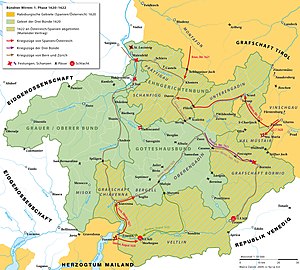Battle of Tirano
| date | September 11, 1620 |
|---|---|
| place | Tirano , Valtellina ( Italy ) |
| Casus Belli | Veltliner murder |
| output | Victory of Habsburg Spain |
| consequences | Valtellina, Chiavenna and Bormio lose three leagues as subject areas |
| Parties to the conflict | |
|---|---|
| Commander | |
| Troop strength | |
| approx. 4300 | |
The battle of Tirano was fought on September 11, 1620 near Tirano in Valtellina between the Three Leagues , Bern , Zurich and Habsburg Spain. It ended with a victory for Habsburg Spain.
prehistory
After the Valtellina murder and the uprising of the Catholic subjects of the Three Leagues in the Valtellina in the summer of 1620, Spanish troops occupied the Valtellina. While the Catholic parishes of the confederations remained inactive for the time being, the Reformed parishes appealed to the Swiss Confederation for military aid. However, the Catholic towns of the Confederation refused to provide assistance, only the Reformed cities of Zurich and Bern sent troops. In August 1,000 people from Zurich and 2,100 people from Bern moved to Graubünden under the command of Colonel Niklaus von Mülinen from Bern and Hans Jakob Steiner from Zurich. Since the Catholic places blocked the march through their areas near Mellingen and Sargans , the troops had to make long detours via Brugg and Toggenburg . The Zurich troops moved through the Prättigau via Davos into the Upper Engadin, while the Bernese got there via the Splügen Pass via Chiavenna . Around 1200 men from the three leagues came to the Engadine under Colonel Johann Guler . Due to the resistance of the Catholic communities against the campaign and the long approach routes, the army of the allies was poorly equipped with weapons and provisions and carried no artillery with them.
The united army first advanced against Bormio via the Casana and Foscagno passes and was able to successfully overcome a Spanish barrier in the Val Viola between Pedenosso and Premadio. On September 3, Bormio fell into the hands of the federal-Graubünden troops without a fight. The starved soldiers plundered the town and had to wait a week for ammunition to be replenished from the Engadin before they could advance further. On September 9, the allies advanced against Tirano, where 28 companies of Spanish and Italian troops awaited them.
Course of the battle
The attack on Tirano took place on September 11th. 300 Graubünden and Bernese formed the vanguard, the Bernese main dog was found in the first meeting, followed by the Graubünden and Zurich troops in the third meeting. It was planned that the three armies would have to line up at Sernio in order to attack at the same time: the Bernese in the middle, the Bündner on the right of the Adda river , the Zurich on the left. Since the terrain and the enemy were either not scouted at all or only poorly, the Bernese made tactical mistakes. They allowed themselves to be tempted by Spanish cavalry to attack beyond their ready positions and were ambushed in the vineyards near Tirano, where the Spanish infantry had holed up. The Bernese suffered heavy losses and lost almost all of their captains at the beginning of the battle, including Colonel Mülinen.
The troops from Zurich and Graubünden, who moved up late, were able to push the Spaniards back against Tirano, but due to a lack of initiative and lack of coordination among the units, they did not succeed in deciding the battle. The waiting troops from the Upper Engadin and Poschiavo did not intervene at all in the fighting. After a counterattack by the Spaniards, the people of Zurich and Graubünden decided to retreat at nightfall due to a lack of ammunition. The Bernese could no longer form a fight.
The retreat did not go as far as Bormio, as planned by the captains. The Bernese were defeated and could no longer be held, the Graubünden people also pushed back to their home communities, as they feared an attack on their respective valleys and the Zurich residents were too weak on their own. For these reasons the campaign to Valtellina was broken off and Bormio was evacuated without a fight.
consequences
The defeat at Tirano ended the direct military interference of the Swiss Confederation in the political-military events in the Three Leagues during the Thirty Years' War known as the Bündner Wirren . As a result, the Drei Bünde had to accept the loss of their subject areas in the Valtellina until 1639. Graubünden itself became the scene of bitter party battles between Habsburg Spain, Venice and France , which only ended in 1639/52.
literature
- Friedrich Pieth : «Switzerland in the Thirty Years War 1618–1648». In: Swiss War History , No. 6. Ernst Kuhn, Bern 1916. pp. 61–104.
